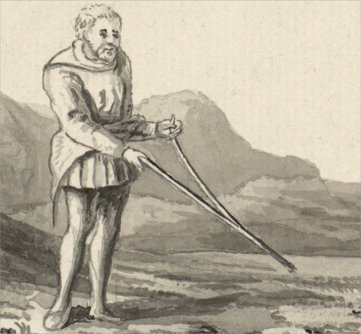
Firstly, what is Dowsing?
Dowsing is the art of searching for hidden objects without mechanical aid.
I call it an Art because Science cannot explain how it works. The nearest they have come is to describe it as ideomotor phenomenon. Roughly speaking that means that the idea in the dowsers mind drives it all. (The same language root as ideology.)
Historically, because it couldn’t be explained, the Catholic Church, among others, thought that it must be Satanic and declared the practice to be a sin. Nowadays we know that Christian missionaries use the skill to find water in remote places in Africa, for example.
So, in dowsing the dowser has in mind what he, or she, seeks and uses a simple device to magnify tiny motions in their hand to indicate when it has been found. Often this will be a balanced rod which is tipped out of equilibrium by the users hand movements.
This implies that the user has somehow detected the subject and how this happens is the mystery. Some people believe that it is one of our basic residual senses that has over the centuries been overwhelmed by modern life. (or hidden; the word occult come from the Latin word for hidden). Some animals possess a ‘sixth sense’ and we may also have these senses - buried, because we now have things like compasses and maps to tell us direction - let alone sat-navs.
Whichever of the many theories as to how and why dowsing works, it seems to; every successful dowser will just know that their theory is right but that doesn’t mean the others are wrong. Even those who have no idea how it works, but it just does.
So, why is Havant a good place to dowse?
The history of the area is well known, from the geology of the South Downs providing us with plentiful springs and fertile soil which encouraged our very early ancestors to live here, through the Roman invasion and their network of roads, and the development of the railway.
This all means that over time our history has been overlaid by thousands of seasons of rain washing top soil to cover up remains, and a great number of underground springs as well as miles of buried service pipes and ducts.
People typically imagine that someone with rods in their hands is looking for water, but it isn’t always so.
My own hobby is tracing buildings and roads which are long gone.
Many places in the country have streets called Pook Lane. Named, I suspect, after the mischievous imp Puck . Our friends the Romans had temples for the soldiers and others, dedicated to their own gods. When the Romans left, their temples were considered to be pagan, inhabited by evil spirits and shunned by the local population. Abandoned and fallen into rubble they were eventually lost and buried under plant growth, trees and dense shrubs, but the locals would have a superstition that it was a mysterious place to avoid at night.
So, I concentrated on thinking if there had been a temple down Havant’s Pook Lane, and in the South side of the main road I got an indication from my rods, driven by tiny movements of my hands, that there had been a Roman Temple deep in the trees.
There are thousands of them and not worth anyone cutting the trees down and digging down 20 feet or so to find a few old stones, but it’s an interesting pastime.
Under the rest of Havant there are springs, buried buildings, rubbish, and general ‘history’ but any dowser has to have an idea what they are looking for, unlike metal detectors which detect the object electronically without knowing what they are detecting until they dig it up.